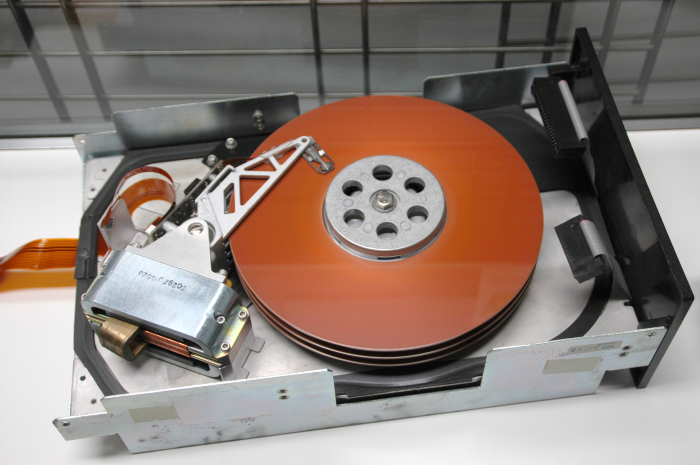Festplatte, Einbau ca. 8 Zoll, Seriennummer BA4115, Modell 1106
W/2013/11/00001

Eine oder mehrere mit einem magnetisierbaren Material beschichtete Scheiben werden durch einen Motor mit hoher Geschwindigkeit angetrieben. Von außen werden Magnetköpfe über die Platte geführt, die die in Form konzentrischer Kreise (Spuren) abgelegten Daten lesen oder schreiben. In der Regel wird eine Magnetscheibe von beiden Seiten beschrieben (2 Magnetköpfe).
Festplatten wurden zuerst in Großrechnern eingesetzt, wo sie mitsamt dem Controller z.T. kühlschrankgroße Geräte ergaben. Im Zuge der Miniaturisierung wurde dann auch der Einsatz als internes Bauteil in Bürocomputern möglich. Die Speicherkapazität lag im Bürocomputer-Umfeld bei 20-50 MByte, im Großrechnerbereich einige 100 MByte.
Quelle: robotrontechnik.de
Hersteller A.Shugart Associates , Shugart Associates was a computer peripheral manufacturer that dominated the floppy disk drive market in the late 1970s and is famous for introducing the 51⁄4-inch minifloppy floppy disk drive.
Founded in 1973, Shugart Associates was purchased by Xerox in 1977. In the early 1980s the name was changed to Shugart Corporation. Xerox exited the business in 1985 and 1986, selling the brand name and the 8-inch floppy product line to Narlinger Group (in March 1986). Narlinger promptly rebranded itself as Shugart Corporation and continued as such into the early 1990s. Under Narlinger management, Shugart acquired several discontinued product lines such as the Optotech 5984 Write Once Read Many (WORM) drive.
History
Alan Shugart, after a distinguished career at IBM and a few years at Memorex, decided to strike out on his own, and in 1973 he gathered up some venture capital and started Shugart Associates. The original business plan was to build a small-business system (similar to the IBM 3740[1]) including the development of all of the major components, including floppy disk drives, a printer, etc. After two years the seed money was gone and Shugart had no product to show for it. The Board wanted to focus on the floppy disk drive but Shugart wanted to continue the original plan. Official company documents state that Shugart quit, but he tells the story another way, that he was fired by the venture capitalists. Shugart went on with Finis Conner to found Shugart Technology in 1979, whose name was changed to Seagate Technology in response to a legal challenge by Xerox.
Shugart SA400 minifloppy 51⁄4-inch disk drive.
The 51⁄4-inch disk drive was developed by Shugart in 1976. The details are a bit unclear though. According to Jim Adkinsson, a Shugart sales manager, Don Massaro, Shugart President, and himself sat down for lunch with a customer who complained that the 8-inch drive was too big for the personal computers then emerging in the nascent S-100 market. When Adkisson asked what the size should be, the customer pointed to a napkin on the table and said, About that size. They returned to the Shugart lab with the napkin and designed the 51⁄4-inch drive. In the story told by Don Massaro the size and basic design was laid out by him and Jimmy Adkisson with cardboard and scissors during a car trip to Herkimer to visit Mohawk Data Sciences. The size was the smallest size that you couldnt put into a pocket.[2] The minifloppy (Shugarts trademarked brand name) was introduced in September 1976[3] as the 110 kilobyte model SA 400 at an OEM price of $390 for the drive and $45 for ten diskettes.[4] The SA-400 and related models became their best selling products, with shipments of up to 4000 drives per day.
In the early 1980s, in order to avoid development and start-up costs, the company turned to Matsushita Communications Inc., a subsidiary of Matsushita, for its half-height 51⁄4-inch drives, starting that company on its way to becoming the largest floppy drive manufacturer in the world. In 1985, in order to resolve an inventory accumulation and as part of its exit strategy, Xerox gave up Shugarts exclusive rights to the Matsushita half-height 51⁄4-inch floppy disk drives.
In 1979, Shugart Associates introduced the Shugart Associates System Interface (SASI) to the computing world; the interface subsequently evolved into SCSI (Small Computer System Interface), and has gone on to change the face of storage. The first standard process completed in 1986 with ANSI standard X3.131-1986 (popularly known as SCSI-1) as the result.
Larry Boucher led the SASI engineering team; he and several of the engineers who worked on SASI left in 1981 to found host adapter maker Adaptec.
Quelle: http://en.wikipedia.org/wiki/Shugart_Associates
Videos
Falls Sie noch mehr sehen wollen...